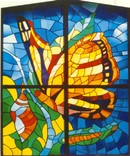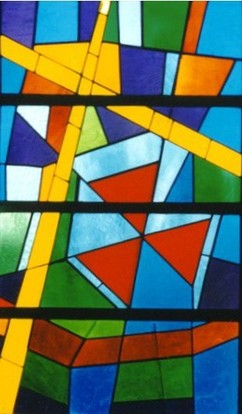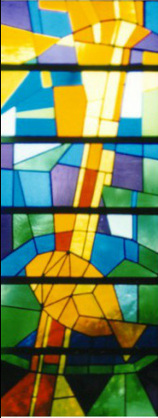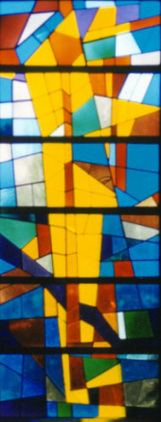Window of Faith

Four Stained Glass Windows designed and executed by Betty Fairbairn (Turner, Vogel) Sokolich.
During the 1970's Boyd Stockdale, a creative minister, had a dream to enhance the sanctuary of the church with stained glass windows. He contacted an artist in the congregation about the possibility of designing and executing one or two windows. Betty Fairbain (at the time Vogel) was an exhibiting artist of a multitude of media who exhibited in many regional exhibitions including the California State Fair, Crocker Art Museum, etc. Stained glass work was a new medium for Betty but she was willing to learn the technique. The Session of Trinity paid for her to attend a class at the University of California, Davis to learn the craft.
During the 1970's Boyd Stockdale, a creative minister, had a dream to enhance the sanctuary of the church with stained glass windows. He contacted an artist in the congregation about the possibility of designing and executing one or two windows. Betty Fairbain (at the time Vogel) was an exhibiting artist of a multitude of media who exhibited in many regional exhibitions including the California State Fair, Crocker Art Museum, etc. Stained glass work was a new medium for Betty but she was willing to learn the technique. The Session of Trinity paid for her to attend a class at the University of California, Davis to learn the craft.
Founder's Window
September 11, 1977 the church was crowded that day of the dedication for the window now called the Founder's Window. Many of the old timers from the 1940's who attended the West acres Community Church in the converted Army surplus Quonset hut were present in the congregation. Betty was surprised when the minister, during the service, introduced her as a Founder but not the artist.
For over twenty years the light streaming through the Founders Window has been a source of joy and inspiration to the congregation as they leave the sanctuary. The bright colors and the symbol of Christ's life and resurrection remind people of God's unending love for all of us.
Wilma Compton had been a staunch member of Trinity for years and on her death many people contributed to Trinity's Memorial Fund. Her family were interested in contributing the money to finance a stained glass window in memory of Wilma. Betty was donating her artistic abilities so the cost was the material and the donated labor of installing the windows. Some of the members of the Session were leery about totally removing the louvered windows so a decision was made to design the stained glass to fit into the louvered window frames which complicated the design to give continuity and make the design flow through the total window space. The design was to be "modern" but some wanted some symbol incorporated into the design.
The symbol of the trinity, Father, Son and Holy Ghost is represented in the smaller window above the door. The Cross is also shown and is placed on an angle to symbolize the dynamic quality of Christianity. The window had just been completed when William Joseph Vogel, Betty's husband, died suddenly from a heart attack. A number of Trinity members suggested that the window be dedicated to Bill who had been a regular attendee at Trinity since he and Betty were married in 1973 and so it was done.
For over twenty years the light streaming through the Founders Window has been a source of joy and inspiration to the congregation as they leave the sanctuary. The bright colors and the symbol of Christ's life and resurrection remind people of God's unending love for all of us.
Wilma Compton had been a staunch member of Trinity for years and on her death many people contributed to Trinity's Memorial Fund. Her family were interested in contributing the money to finance a stained glass window in memory of Wilma. Betty was donating her artistic abilities so the cost was the material and the donated labor of installing the windows. Some of the members of the Session were leery about totally removing the louvered windows so a decision was made to design the stained glass to fit into the louvered window frames which complicated the design to give continuity and make the design flow through the total window space. The design was to be "modern" but some wanted some symbol incorporated into the design.
The symbol of the trinity, Father, Son and Holy Ghost is represented in the smaller window above the door. The Cross is also shown and is placed on an angle to symbolize the dynamic quality of Christianity. The window had just been completed when William Joseph Vogel, Betty's husband, died suddenly from a heart attack. A number of Trinity members suggested that the window be dedicated to Bill who had been a regular attendee at Trinity since he and Betty were married in 1973 and so it was done.
This is a view of the three windows on the North wall of the church. From Left to right, the Trinity (the second window finished), The Fish (the first window finished) and Epiphany (the last window finished).
|
Dedicated to William Joseph Vogel
The second window is the symbol of the Trinity, Father, Son and Holy Ghost
The Fish has long been a symbol of Christianity so the north middle window was designed in an abstract way but included the fish. The first section was installed in 1974 into the middle window. The congregation could watch the progress as each section was finished |
Dedicated to Wilma Compton
The first window was dedicated to Wilma Compton. The men who installed the section were Gene Axtell, Chuck Johnson and Kelly McClure.
|
Dedicated to William Pitt Turner, III
The third Window symbolizes, in abstract design, the Epiphany
|
William Pitt Turner, III, Betty's late husband who died in 1969, had been a tireless worker for Trinity so the Session suggested that the rear window be designed and dedicated to Pitt. At the dedication Boyd Stockdale paraphrased Betty's interpretation "It is the most abstract of the windows and does not have the symbols of the other two. It symbolizes, in abstract design, the Epiphany-- the season of the year and the time in our life when Christ is shown to us. Christ is shown forth in Epiphany-- that's the season of the year and is also something that is a part of each of our lives...that this symbolizes the Epiphany of Christ...the showing forth of His life and His love. The yellow is that symbol of life, of light...the showing forth...the light of the world..the yellow that dominates this window in it's color. And yet the whole window, with all of those various colors, is that symbol of the joy of faith; the joy at receiving the Epiphany of Christ...and in itself represents the joy of faith, the joy that we know in faith. It is a beautiful and magnificent window, and every time we see it we can be reminded of faith and the joy of faith..the Epiphany of our Lord as He was shown forth to us.". The dedication was on December 7, 1975.
The Eric Hughes family wanted to have the large window above the Sanctuary door used for a stained glass window in memory of Eric and Jenny Hughes, parents and grandparents and long time members of Trinity. After some discussion about a theme, "Resurrection" was selected as the subject. The area is 10 by 8 feet and would need to be reinforced to hold such a large window safely. Pitt Turner, IV a licensed engineer, Betty and Pitt, III's son who grew up in Trinity, designed and provided the necessary metal structure support to do the job. The design had to be in four parts. The life of a butterfly is a symbol of the Resurrection so that became the motif and the window was dedicated to the Founders of the church.
In order to involve some of the members of the church in the project Betty conducted a class in her studio on the techniques of stained glass for those interested in helping to create the window. The workers who worked on the main window were Bara Edwards, Jane Gibson, Floy Gleason, Chuck Johnson, Lillian Kale and Sue Stockdale.
The Eric Hughes family wanted to have the large window above the Sanctuary door used for a stained glass window in memory of Eric and Jenny Hughes, parents and grandparents and long time members of Trinity. After some discussion about a theme, "Resurrection" was selected as the subject. The area is 10 by 8 feet and would need to be reinforced to hold such a large window safely. Pitt Turner, IV a licensed engineer, Betty and Pitt, III's son who grew up in Trinity, designed and provided the necessary metal structure support to do the job. The design had to be in four parts. The life of a butterfly is a symbol of the Resurrection so that became the motif and the window was dedicated to the Founders of the church.
In order to involve some of the members of the church in the project Betty conducted a class in her studio on the techniques of stained glass for those interested in helping to create the window. The workers who worked on the main window were Bara Edwards, Jane Gibson, Floy Gleason, Chuck Johnson, Lillian Kale and Sue Stockdale.


